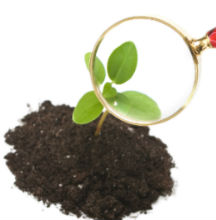Choosing the right plant for the right place is the single most important factor in creating a successful garden. When the right plants are matched with the right conditions, they will be stronger and more resilient, reducing water needs and reduced pesticide use. Placing plants where they will do their best can go a long way towards a healthy, beautiful, watershed-friendly landscape in your own yard.
Soil types, temperature ranges and rainfall patterns differ dramatically from region to region within Virginia; in fact, there are distinct variations even within Loudoun County. A plant that thrives in a nearby friend’s yard may struggle in yours. Conditions likely vary within the bounds of your own yard. For instance, your front yard may be exposed and dry, but your backyard may be damp and shady.
The design of any landscape has an impact on maintenance needs. Selecting the right plants and placing them in appropriate spots can reduce chores like pruning, fertilizing, and watering, saving not only time but money. Be sure to consider factors such as plant temperature tolerance, flooding or saturated soils, shade, dry areas, and use when planning your backyard design.
Spotlight: Green and Gold groundcover:

Turfgrasses require more frequent watering and maintenance than most other landscape plants. Consider defining areas of your yard to keep in turf for pets and children, for instance, and replacing other turf areas with a groundcover. Green and Gold (Chrysogonum virginianum) is a low, spreading groundcover, particularly in the front of a naturalized area or woodland landscape. (photo from Clemson.edu)
My Backyard Measures for Scorecard
- Note the growing conditions in and natural features of your yard, including your microclimate, soil quality, amount of sunlight and other factors that may affect successful plant growth. Credit = 2 inches
- Determine how much open lawn area you desire for children, pets, and recreation. Then, choose plants suited to the site conditions specific to your yard, focusing on plants that thrive predominantly on rainfall once established. Try to reduce lawn area, which requires more maintenance. Credit = 2 inches
- Choose low-maintenance groundcovers, shrubs, mulch, or other porous materials that allow water to infiltrate the surface. Credit = 3 inches
- Group plants according to their water and other maintenance needs to facilitate providing appropriate levels of water and light to all plants. Credit = 3 inches
- Choose plants that will not require frequent pruning for their location once they reach maturity. Credit = 2 inches
- Locate trees and shrubs on the eastern and western walls of your home, to help decrease energy use. Credit = 2 inches
- Locate deciduous trees or shrubs on southern exposures, to allow sunlight to heat your home passively in winter. Credit = 2 inches
- Proper tree and shrub planting will ensure a long and healthy life for the plants, saving the homeowner time and money in future maintenance. Credit = 3 inches.
Resources
- USDA Interactive Plant Hardiness Map
- VCE Publication 426-609: Selecting Landscape Plants: Groundcovers
- VCE Publication 426-611: Selecting Landscape Plants: Flowering Trees
- VCE Publication Hort 84: Selecting Plants for Virginia Landscapes: Showy Flowering Shrubs
- VCE Publication 426-701: Shrubs: Function, Planting and Maintenance
- VCE Publication 426-617: Planting on Your Septic Drain Field
- VCE Publication 426-722: Reducing Erosion and Runoff (plants to assist)
- VCE Publication 430-462 Shrub Pruning Calendar and Successful Shrub Pruning
- VCE Publication 430-461 Evergreen Pruning Calendar and Successful Evergreen Pruning
- VCE Publication 430-460: Guide to Successful Pruning: Deciduous Tree Pruning Calendar



